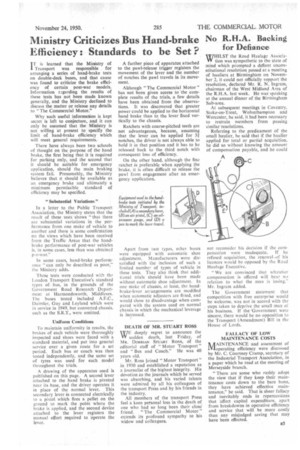Ministry Criticizes Bus Hand-brake Efficiency: Standards to be Set ?
Page 39

If you've noticed an error in this article please click here to report it so we can fix it.
IT is learned that the Ministry of Transport was responsible for arranging a series of hand-brake tests on double-deck buses, and that cause was found to criticize the brake efficiency of certain post-war models. Information regarding the results of these tests has not been made known generally, and the Ministry declined to discuss the matter or release any details to "The Commercial Motor."
Why such useful information is kept secret is left to conjecture, and it can only be assumed that the Ministry is not willing at present to specify the limit of hand-brake efficiency which will meet general requirements.
There have always been two schools of thought on the purpose of the hand brake, the first being that it is required for parking only, and the second that it should be suitable for emergency application, should the main braking system fail. Presumably, the Ministry believes that it should be available as an emergency brake and ultimately a minimum permissible standard of efficiency may be specified.
"Substantial Variations" In a letter to the Public Transport Association, the Ministry states that the result of these tests shows "that there are substantial variations in the performance from one make of vehicle to another and there is some confirmation on the views which have been received from the Traffic Areas that the handbrake performance of post-war vehicles is. in some cases, less than was obtained p re-wa r."
In some cases, hand-brake performance "can only he described as poor," the Ministry adds.
These tests were conducted with the London Transport Executive's standard types of bus, in the grounds of the Government Road Research Department at Harmondsworth, Middlesex. 1 he buses tested included A.F.C., Daimler, Guy and Leyland which were in service in 1949, but converted chassis, such as the S.R.T., were omitted.
Uniform Conditions To maintain uniformity in results, the brakes of each vehicle were thoroughly inspected and shoes were faced with a standard material, and put into general service over a given route for a set period. Each bus or coach was then tested independently, and the same set of tyres was used for each model throughout the trials.
A drawing of the apparatus used is published on this page. A second lever attached to the hand brake is pivoted near its base, and the driver operates it in place of the normal lever. This secondary lever is connected electrically to a pistol which fires a pellet on the ground to mark the point where the brake is applied, and the second device attached to the lever registers the manual effort required to operate the lever.
A further piece of apparatus attached to the pawl-release trigger registers the movement of the lever and the number of notches the pawl travels in its movement.
Allhough "The Commercial Motor" has not been given access to the complete results of the trials, a few details have been obtained from the observations. It was discovered that greater power could be applied to the horizontal hand brake than to the lever fixed vertically to the chassis.
Ratchets with coarse-pitched teeth are not advantageous, because, assuming that the lever can be applied for 3i notches, the driver is not always able to hold it in that position and it has to be released back to the third notch with consequent loss of efficiency.
On the other hand, although the fine ratchet is preferable when applying the 'brake, it is often difficult to release the pawl from engagement after an emergency application.
Apart from two types, other buses were equipped with automatic shoe adjustment. Manufacturers were dissatisfied with the inclusion of such a limited number of types of vehicle in these tests. They also think that addisional trials should have been made without automatic shoe adjustment. In one make of chassis, at least, the handbrake-lever arrangements are modified when automatic adjusters are fitted, and would show to disadvantage when compared with the system used on normal chassis in which the mechanical leverage is increased.
DEATH OF MR. STUART ROSS WE. deeply regret to announce the W sudden death, last Friday, of MR. DORRIAN STUART Ross, of the editorial staff of "Motor Transport" and "Bus and Coach." He was 40 years old.
Mr. Ross joined "Motor Transport" in 1930 and established a reputation as a journalist of the highest integrity. His devotion to the journals which he served was absorbing, and his varied talents were admired by all his colleagues of the transport Press and by his friends in the industry.
All members of the transport Press feel a keen personal loss in the death of one who had so long been their close' friend. "The Commercial Motor" extends its profound sympathy to his widow and colleagues.




























































































